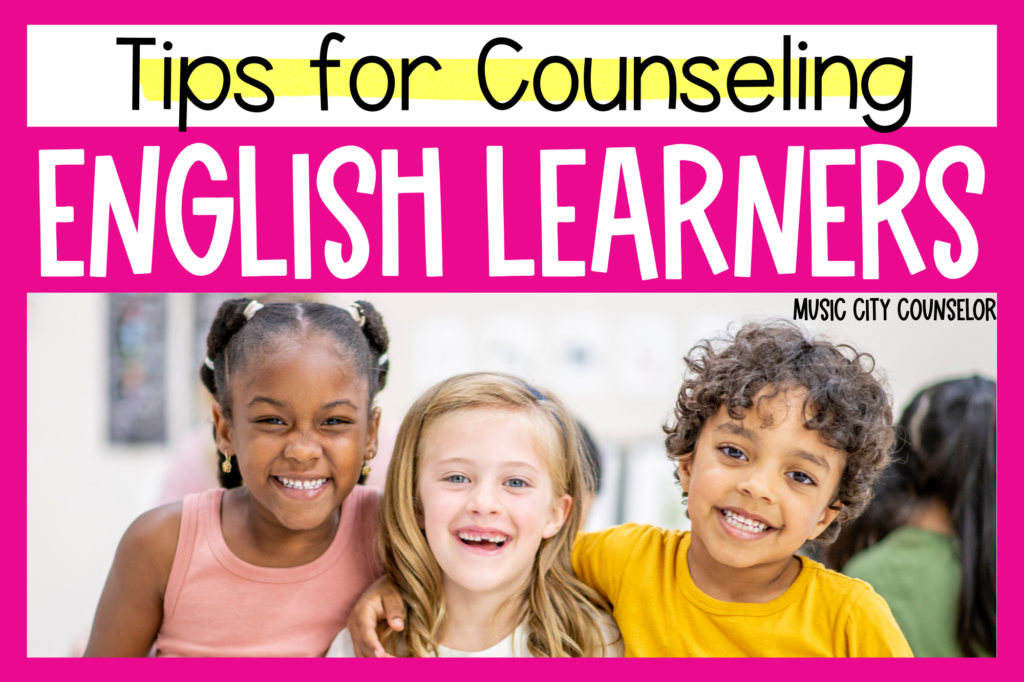
Did you know that over 5,000,000 students in the United States are English Learners, and this number is increasing each year? With more and more students from non-English backgrounds entering our schools, the need for meaningful and relevant counseling services for this special population is growing! But, how do English-speaking school counselors serve English Learners, despite the language barrier?
In this post, you’ll learn 10 tips for counseling English Learners, from the perspective of a bilingual school counselor!
10 Tips for Counseling English Learners

1) Be patient, understanding and kind.
It’s difficult for most of us to even imagine the immense challenges facing our immigrant and EL students. Many of our immigrant families are living in fear of deportation every single day and, despite working long hours, struggle to provide for their family’s most basic needs. EL students and their families may feel misunderstood, unwelcome, out of place, and “different” wherever they go. Parents may be unwilling to attend school events, parent/teacher conferences, etc. out of fear that the school may report their immigration status to authorities (which, by the way, is NOT our job!).
As educators, it is our responsibility to make sure our students and their families feel welcome, cared for, and safe inside the doors of our school. When we are patient, understanding, and kind, and meet these families where they are, we can be a light in these sweet families’ lives.
2) View bilingualism as a gift, not a burden.
When we adopt a strength-based approach, we view ELs’ language needs as a gift, not a burden. Speaking two languages is an incredible asset that will set them apart in the career world, and open up countless doors and opportunities for them!
Several of my students came to us directly from foreign countries and did not speak a single word of English when they first walked through our doors. Seeing their language skills and confidence grow and blossom over their elementary years just took my breath away! What a privilege it is to be part of EL students’ language journey. As they grow older, they will remember those of us who welcomed them and valued their differences. And we will remember them, too.
3) Learn about your students’ cultures.
Taking the time to learn who our students are and where they come from is crucial to becoming a culturally sensitive practitioner. Yes, there are similarities between neighboring countries in their beliefs, customs, cuisine, cultural norms, language, etc. But, there are just as many differences between cultures as there are similarities! When we take the time to ask questions, do research, and get to know our families on a personal level, the connection and level of understanding we have for each other grows exponentially!
4) Learn simple vocabulary and phrases in their language.
Greeting students and their families with a warm smile and a “hello” in their native language is so simple to do, yet makes a BIG impact! Learning a few vocabulary words and greetings in languages represented at your school helps ELs feel seen, welcome, and at home.
Here are some helpful phrases and vocabulary words in Spanish for school counselors. If your school has languages other than Spanish represented, I encourage you to learn a few greetings or words in those languages, too!

5) Make use of translation services.
Counseling, like prayer or meditation, is an intimate, personal, and deep experience. Connecting with students and their families in the language of their heart, without them needing to translate their thoughts and feelings, is ideal because it allows for authentic, genuine, and heartfelt connection.
Large districts, and districts with high EL populations, often have translation services available. In my district, I was able to schedule a translator for any of our major languages to attend meetings with parents. I also requested them to attend counseling sessions and groups on occasion! This helped my students and their families feel more comfortable, and ensured that that information was shared as accurately as possible.
If you do not have access to human translators, online translators are the next best thing! They have come a LONG way in recent years, and are becoming more and more accurate! The Google Translate app is a free download that has several options for translation services, including continuously translating speech, taking images of documents and translating them, and translating text.
6) Speak clearly and directly.
Be intentional about the language that you use with EL students. With beginners, speak in short, clear, simple, and direct sentences. (Do not speak louder, this will not help!) Avoid jargon, idioms, or colloquialisms.
For example, when teaching about emotions, avoid saying, “Julia is feeling blue today” – imagine the confusion that could cause! Instead, be more direct and say, “Julia is feeling sad today.”
Gestures and hand motions are very helpful, too! It definitely takes practice and effort, but anything we can do to enhance our students’ understanding of our speech is well worth it!
7) Visuals, visuals, visuals!
Offer rich, eye-catching, and engaging visual aids when working with ELs. Use a mix of digital images on a SmartBoard, realia, printed photographs, and clipart to enhance understanding. Words can only go so far and although it may sound cliché, a picture is truly worth a thousand words!
Look for instructional materials that don’t require English language skills and rely heavily on visuals. For example, this Choices and Behaviors Activity teaches students positive behaviors with an image-based sorting game.
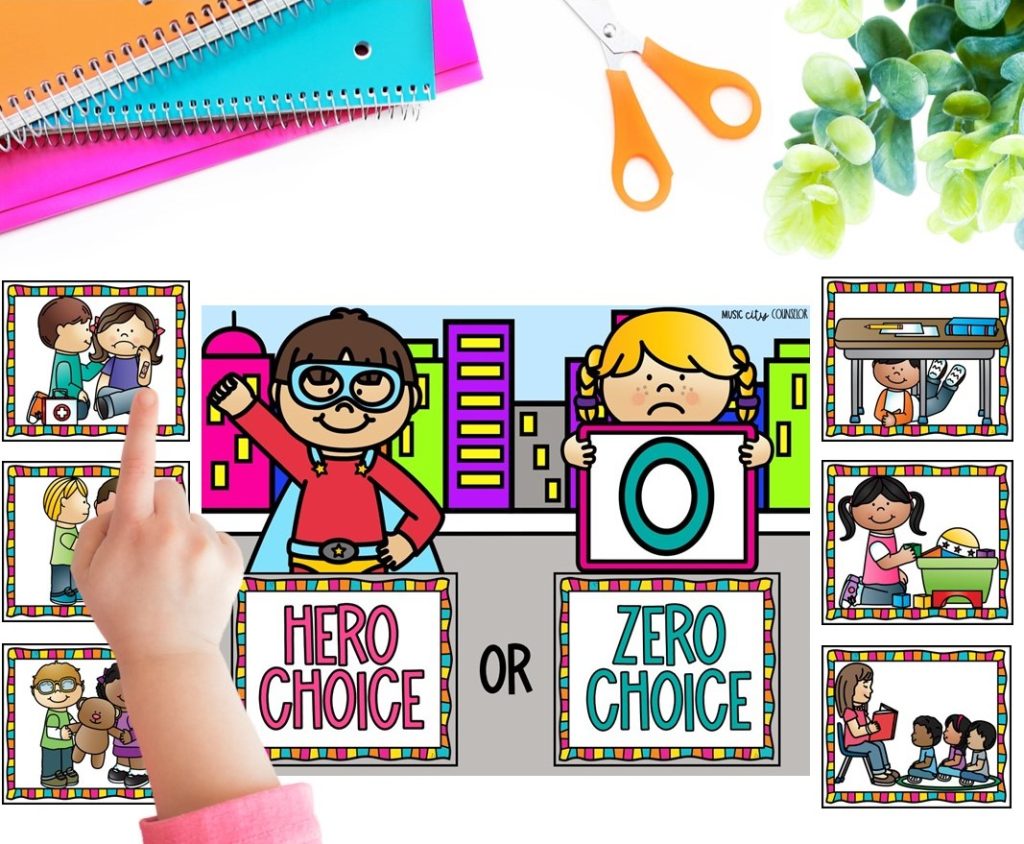
8) Send bilingual documents home.
It takes extra effort and photocopies, but sending home flyers, letters, notes, and invitations home in a language parents can understand is critical. We cannot expect immigrant families to be involved in their child’s education, attend meetings or special events, or be aware of day-to-day happenings if we only send home documents in English! Make use of the translation services available in your district and, if they are not available or accessible, use Google Translate. It will get the point across!
9) Use and display bilingual SEL and counseling resources.
Walking into a school building with visuals and decor in their native language makes ELs feel like they belong. Bilingual counseling and SEL resources can be hard to find, but I encourage you to search them out and provide them whenever you can!
A simple place to start is to display feelings charts in both languages in your Calm Corner or counseling space. Here’s a free one that you can use!
Displaying bilingual bulletin boards and posters is another wonderful way to make ELs feel included. Here are some feelings posters in English and Spanish that are included in our Counselor Collab Membership!
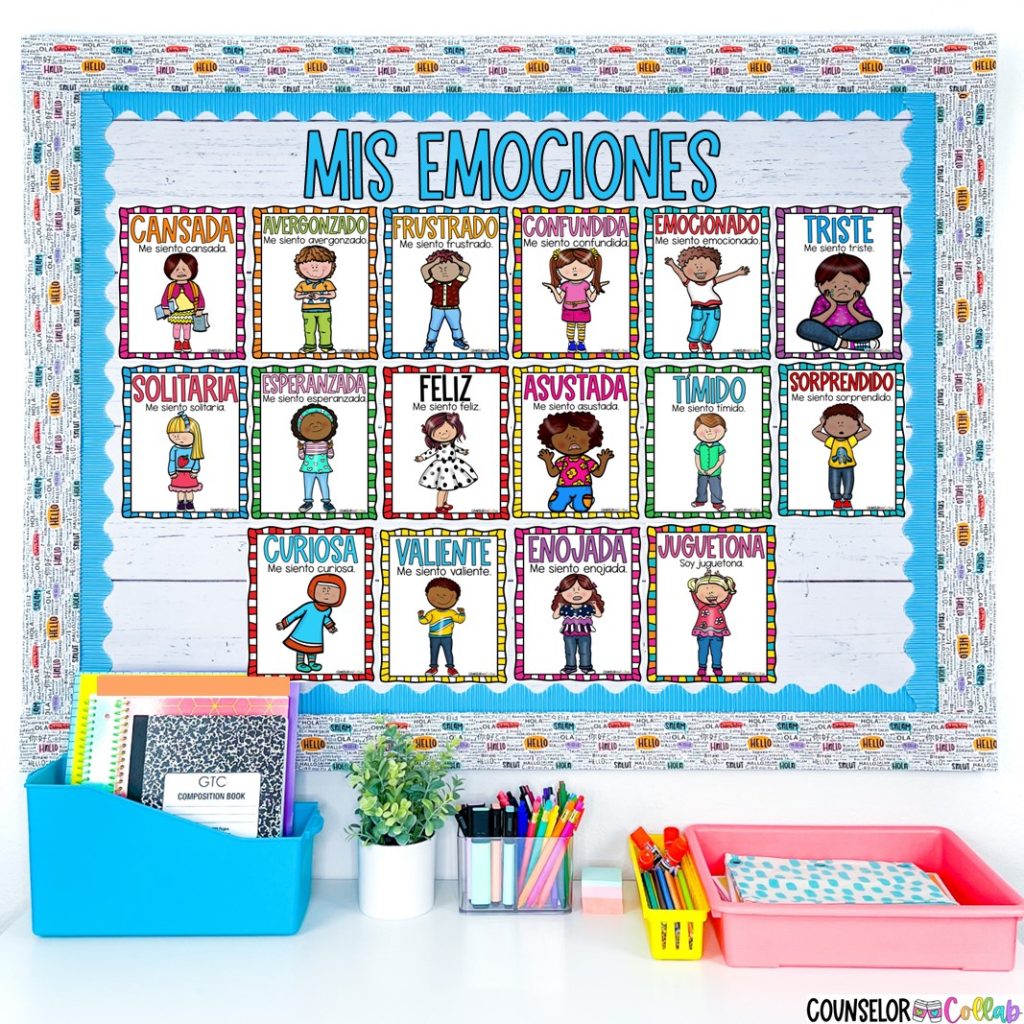
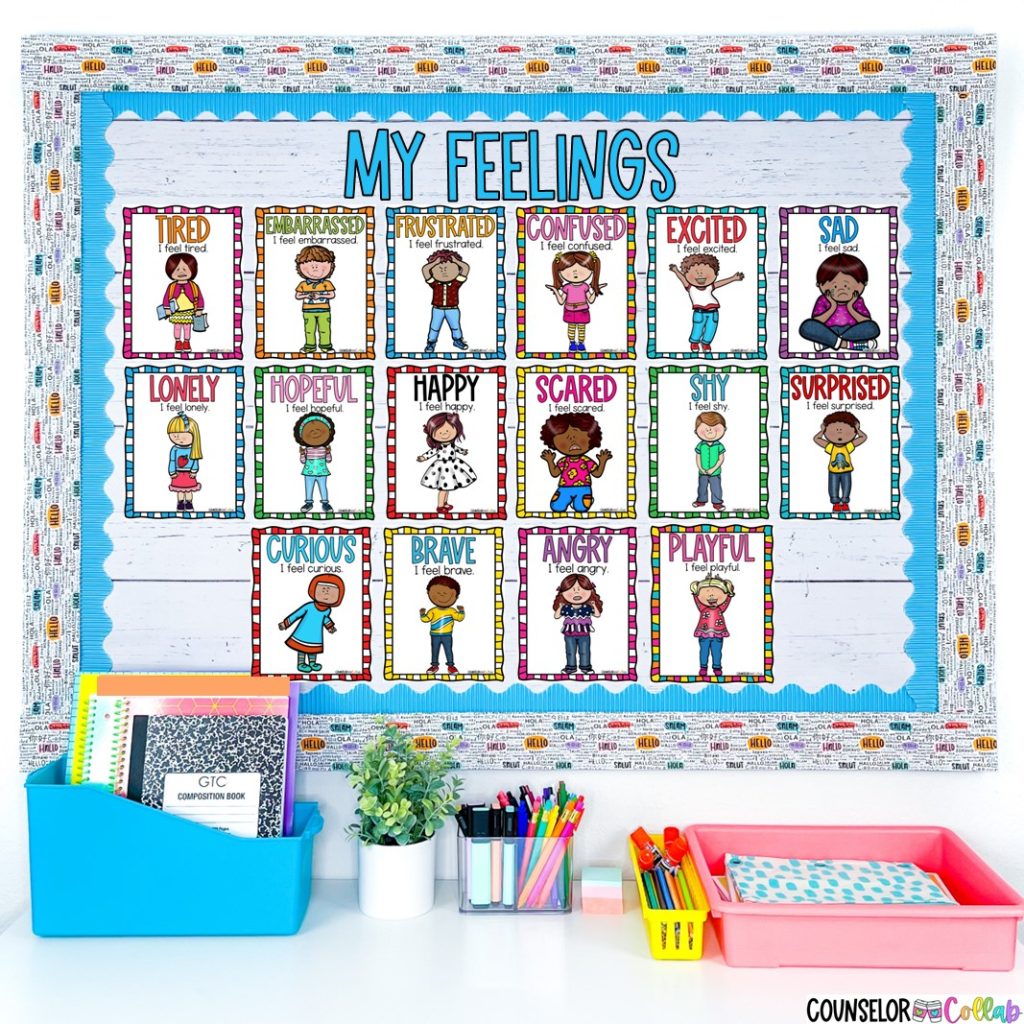
Here are some of my other favorite bilingual SEL and counseling resources:
- Career City: Virtual Career Day
- Test Anxiety Lap Book
- Feelings Matching Game
- Careers Matching Game
- Coping Skills Matching Game
- Counseling Needs Assessments
10) Empower parents to be part of their child’s learning.
In my experience, many (not all!) of my EL parents saw the home and school as two very separate entities that were not intertwined. They believed that their responsibility was to teach their child behavior, manners, etc. at home and our responsibility was to teach their child to read, write, etc. at school. Due to the language barrier, they felt unable to help their child with homework or reinforce academic learning at home. Many of my EL parents also feared that speaking or reading books aloud in their native language may confuse the child or hinder their English language development.
In reality, the stronger the child’s foundation in their native language, the easier it will be for them to develop their English language skills! And in today’s multicultural society, their native language skills will be absolutely crucial in their professional and personal life as they grow, and could be a game-changer when they eventually search for a job!
It is crucial that educators send the message that immigrant parents CAN help their child learn – and are, in fact, a CRITICAL part of their child’s education. When I met with parents and offered after-school parenting workshops, I loved to give little tips to help them become more involved in their child’s learning. I encouraged them to:
- Read stories aloud in their native language, then ask “W” questions about the text
- Use apps such as Google Translate to translate sight words, homework assignments, etc.
- Apply for a library card so their child can check out age and level appropriate books
- Incorporate learning into every day life – (i.e. when you’re cooking, have the child count the number of beans or measure the ingredients. When you’re checking out at the grocery store, have the child count the money).
The key here, and the educators’ responsibility, is to help parents understand that they CAN help their child learn and to EMPOWER them to do so.
No matter how big or small the EL population is at your school, I hope that these tips and pieces of advice were helpful to you! What is your best advice for working with English Learners? Please comment below, I’d love to hear from you!

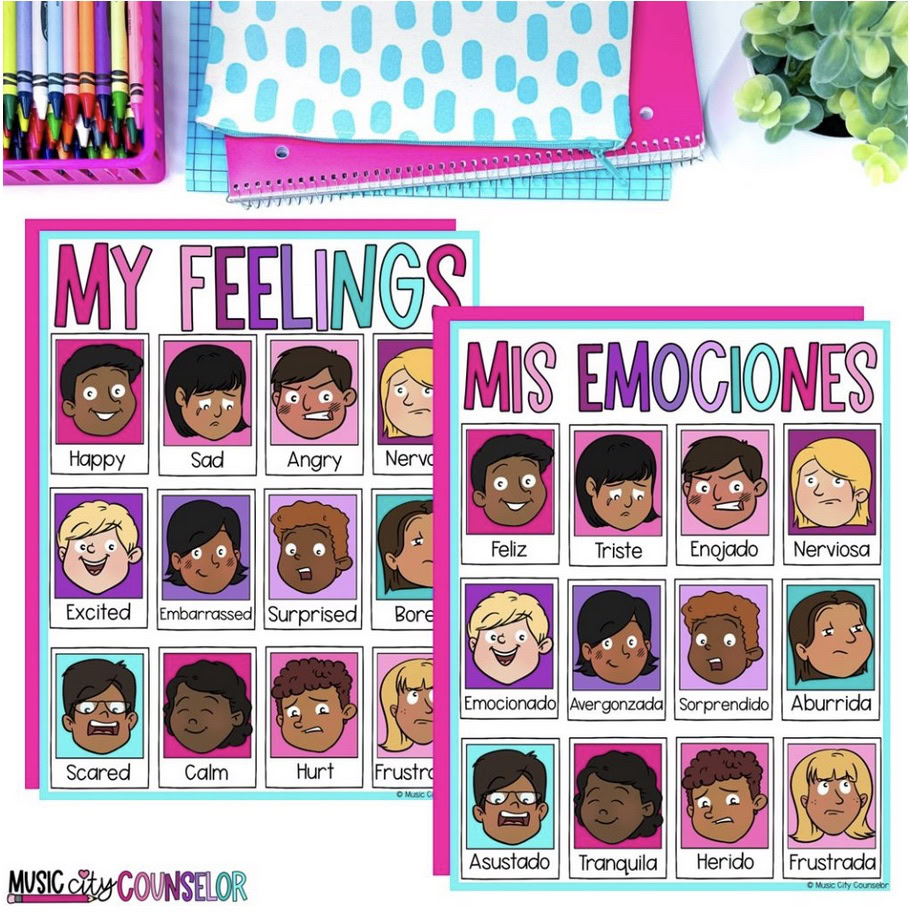


I LOVE LOVE LOVE this post! I have more recently been advocating for the SE needs of our ELL population as I truly feel they need more support, but I cannot pinpoint what that may look like! This is the perfect printout and I was hoping I could access it as a PDF so it is a clean print out to share ??
Thank your for sharing your knowledge and amazing skills!
Maura
Aww thank you so much, Maura! You’re so sweet! And thank you for seeing the need for more supports for your ELL students – you’re a hero! Which print-out are you referring to? I’m happy to share!
The entire blog post “Tips for Counseling English Language Learners”! When I select to print it cuts off a lot and with my OCD , Type A (lol) personality, I wanted it nicely outlined as in your blog in color. If you can!
Hi Maura! Totally understand! I haven’t tried printing blog posts before. I imagine the sizing and layout wouldn’t work well for printing. Perhaps you could try saving screenshots and printing those? Or just sharing the website link electronically with your school community? Sorry for the trouble!
This is great information. So appreciated. Do you have a small group curriculum for English Learners? I am getting ready to create something because I just don’t see anything out there. I plan to do lessons on communicating with friends and staff, expectations at school, etc.
Thanks so much for your kind words! Great question! I do have a social emotional learning curriculum that would work very well with English Learners and can be used with small groups and whole groups! It includes materials for 9 sessions! I’ll link it here for you: https://www.teacherspayteachers.com/Product/SEL-Social-Emotional-Learning-Counseling-Curriculum-9-Lessons-10072048